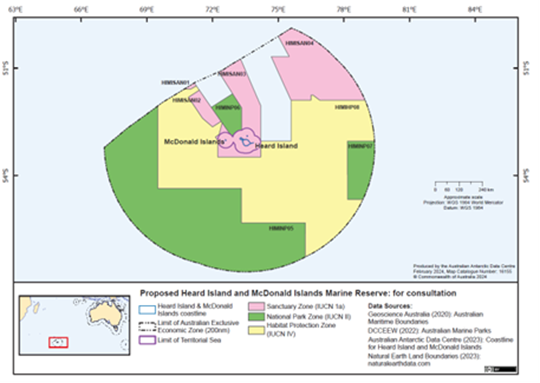Australia's massive expansion of the Heard and McDonald Islands Marine Reserve aims to boost conservation - but a new research report raises tough questions about its effectiveness for the future management of the region's fisheries and broader ocean governance.
By Dempsey Ward
Australia’s Heard Island and McDonald Islands (HIMI) Marine Reserve has quadrupled in size — a dramatic 400% expansion that brings its total protected area to a staggering 379,070 square kilometres.

But while the authors of a new FRDC report say this expansion has some merit, questions emerged about whether this ambitious expansion truly aligns with the principles of Ecologically Sustainable Development (ESD) — the core framework underpinning Australia’s marine policy for decades.
The expansion adds new National Park Zones (IUCN II) and Habitat Protection Zones (IUCN IV), effectively reshaping not just the physical footprint of the reserve, but also its management rules. This shift has far-reaching implications, particularly for HIMI fisheries; Patagonian toothfish (Dissostichus eleginoides) and Mackerel Icefish (Champsocephalus gunnari). Both fisheries are certified by the Marine Stewardship Council and have been given the green light in the latest Status of Australian Fish Stocks Report.
Both fisheries combined bring in an average of over 3,500 tonnes of high-quality fish and provide direct and indirect employment of both Australian and international workers.
The report outlines that Australia’s Environment Protection and Biodiversity Conservation Act 1999 and the Fisheries Management Act 1991 are clear: environmental, social and economic factors must all be balanced under ESD principles. However, co-author of the report Travis Baulch contends that the massive expansion of the HIMI Marine Reserve suggests a possible departure from this holistic approach.
"The HIMI fishery has been operating under some of the world's most stringent sustainability standards," explains Travis.
Indeed, the Habitat Protection Zones now overlap much of the existing fishing grounds, casting doubt over future access, gear use, and even market perception.
The report adds that with Australia's commercial fishing sector already under pressure to meet evolving conservation targets, these new restrictions risk one of the country’s most well-managed fisheries — one that contributes directly to employment, food security and regional governance.
The report also raises technical questions about the reserve’s effectiveness. The National Representative System of Marine Protected Areas (NRSMPA), established more than 25 years ago, was designed to create a network of areas that reasonably represent Australia's marine biodiversity. Yet, recent research shows that the pre-expansion HIMI reserve already covered most key conservation values in the region. "The expansion goes well beyond what’s required under global biodiversity frameworks, including the 30x30 target,” states Travis.
While adding some underrepresented habitats makes sense, Travis argues that a 400% increase seems excessive, particularly when threats like climate change pose the greatest risk to the area’s ecosystems.
“Expanding the HIMI reserves, and marine reserves in general, will do little to mitigate this threat.”
Lack of Transparency
The report delves into the lack of transparency in the reserve’s redesign process. Previous iterations of marine spatial planning (MSP) for HIMI involved detailed ecological risk assessments and public consultations grounded in ESD principles. This time, however, the process appears less clear. The public consultation paper cites broad goals but doesn’t specify how threat levels were assessed or how the new zones will mitigate pressures.
The report concludes that the ramifications go beyond fisheries. With the HIMI fishery being a key provider of scientific data for the region through its Random Stratified Trawl Surveys — research could now be jeopardised, as trawling methods are restricted in the new zones. Limiting scientific access could reduce Australia’s ability to monitor and manage the very ecosystems it aims to protect.
Travis states that research is increasingly advocating for dynamic management frameworks that can adapt to ecological changes, rather than simply expanding fixed no-take zones.
“As Australia positions itself as a leader in global marine conservation, the HIMI Marine Reserve expansion serves as both a milestone and a mirror — reflecting the challenges between ambitious conservation goals and the need for sustainable, science-based management,” Travis says.
“Without recalibrating the balance between ecological, social and economic outcomes, Australia risks undermining not just the HIMI fishery but its broader model of marine governance.”
Related FRDC Project
2023-205: Role of marine reserves in sustainable management of Australia’s ocean estate – a critical review of the Heard Island and McDonald Islands marine reserve expansion





